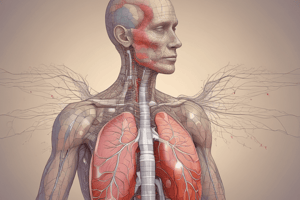Podcast
Questions and Answers
explain the mechanics of breathing
explain the mechanics of breathing
Inspiration: diaphragm contracts, extending chest cavity downwards intercostal muscles contract, extending rib cage upwards and outwards chest cavity volume increases pressure decreases air flows from higher pressure to lower pressure in lungs
expiration: diaphragm relaxes, pushing up into chest cavity rib cage moves down and inwards chest cavity volume increases air flows from higher pressure in lungs to lower pressure outside
How is the lung suited for gas exchange
How is the lung suited for gas exchange
hundreds of millions of alveoli give lungs huge internal surface area for large amounts of gas exchange
each alveolus well supplied with BV, so as much blood as possible is close to the air in alveolus and continuous flow of blood maintain concentration gradient of oxygen and carbon dioxide between blood and air in lungs
alveoli membrane is very thin so gas molecules do not have far to travel- increase efficiency of gas exchange
lungs are positioned deep inside body to prevent excessive evaporation of fluid that covers respiratory surfaces.
Important for alveoli membrane to be covered in thin film of moisture so gases can dissolve and hence diffuse into and out of the blood
respiratory muscles can move to change lung volume so we constantly inspire and expire, which maintains concentration gradient of oxygen and carbon dioxide between air and blood
describe the process of gas exchange
describe the process of gas exchange
blood in capillaries surrounding alveoli is brought to lungs by pulmonary artery
blood is deoxygenated (low concentration of oxygen, lower than concentration in the air in alveolus)
oxygen dissolves in moisture on inside of alveolus and diffuses through membrane on walls of capillaries and into blood
blood arriving at capillaries of alveoli has come from body circulation where it has picked up CO2 produced by respiration in cells
concentration of CO2 is higher in alveolar capillaries than in air in alveolus
so CO2 diffuses out of blood and into air in alveolus
how is concentration gradient for oxygen and carbon dioxide maintained
how is concentration gradient for oxygen and carbon dioxide maintained
emphysema
emphysema
Describe how lung cancer begins and progresses
Describe how lung cancer begins and progresses
describe the characteristics of asthma
describe the characteristics of asthma
what are the triggers for asthma flare up
what are the triggers for asthma flare up
Flashcards are hidden until you start studying




